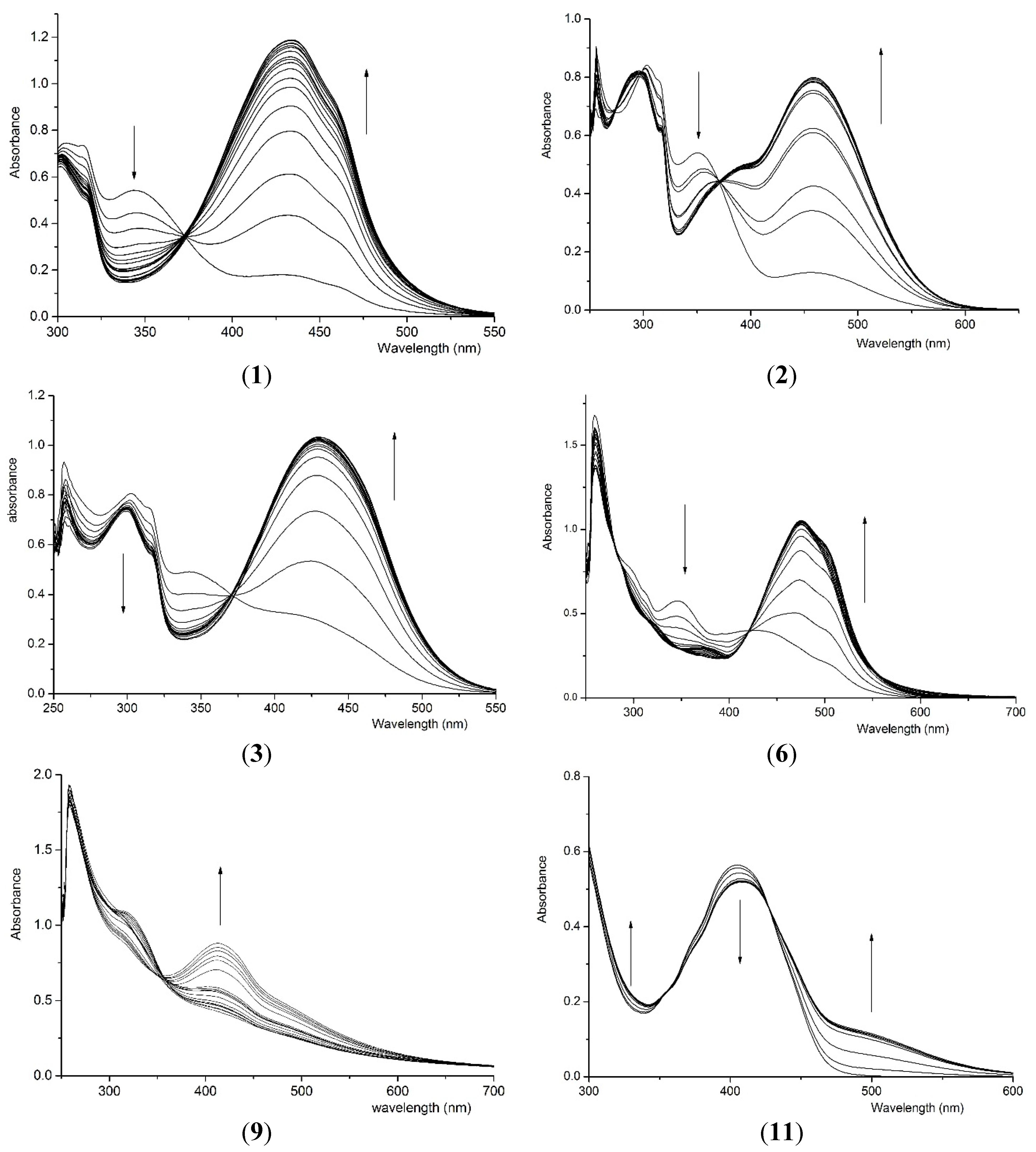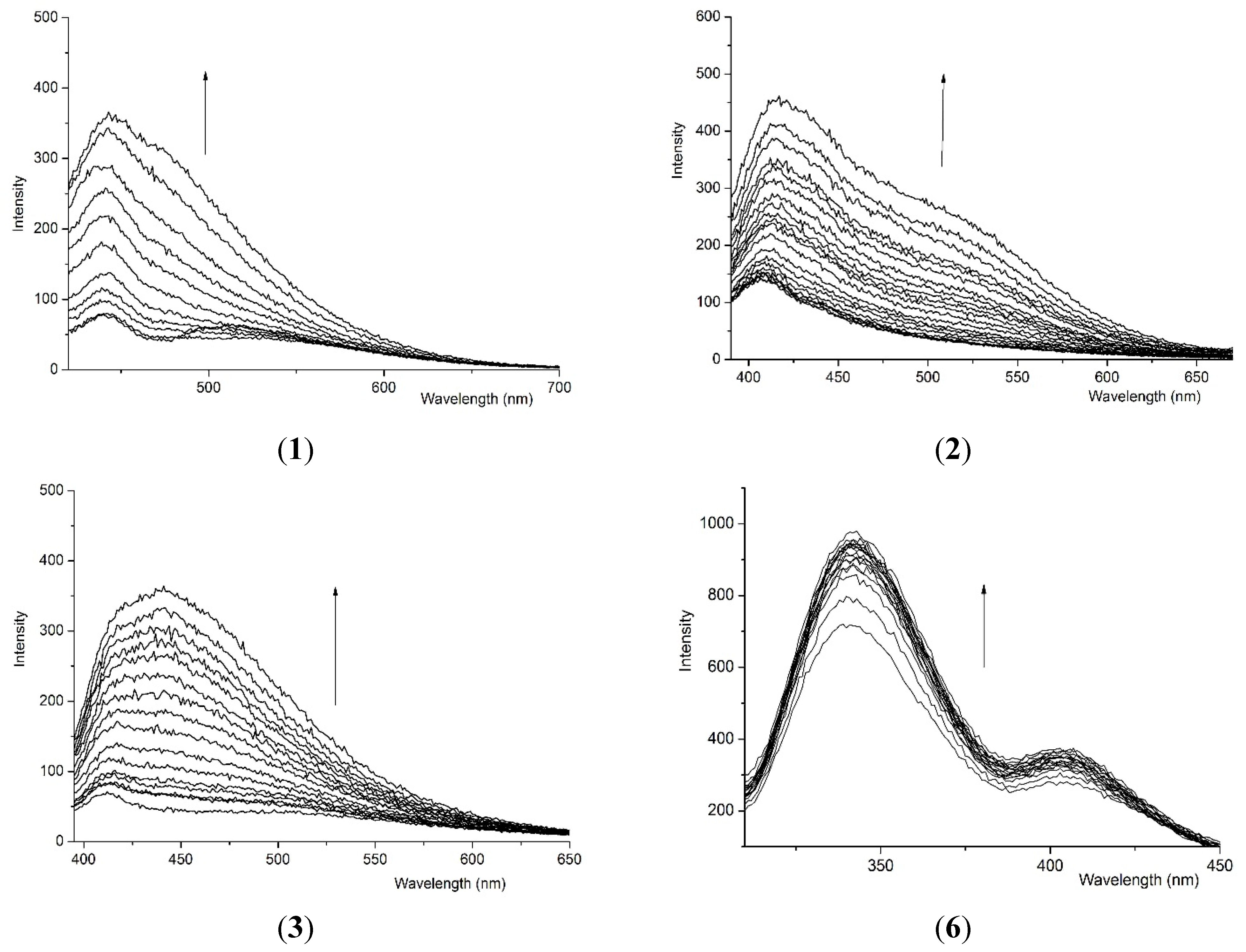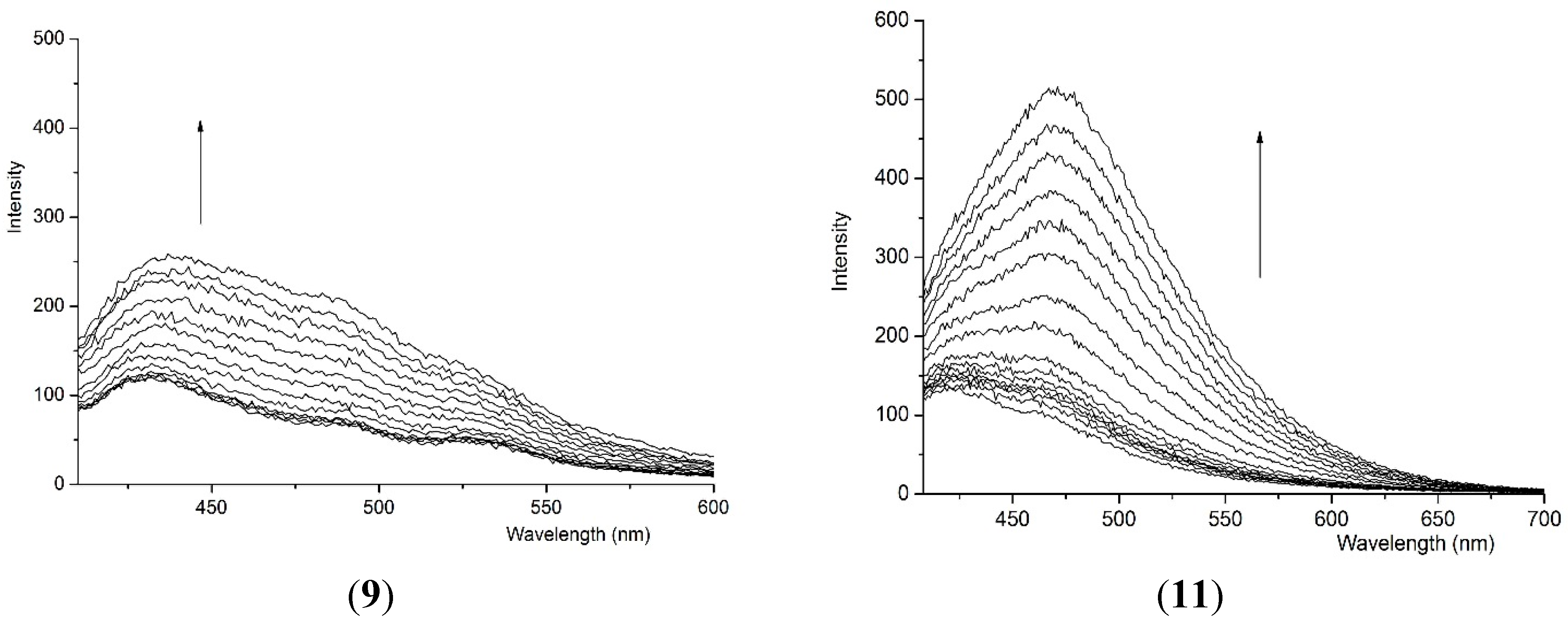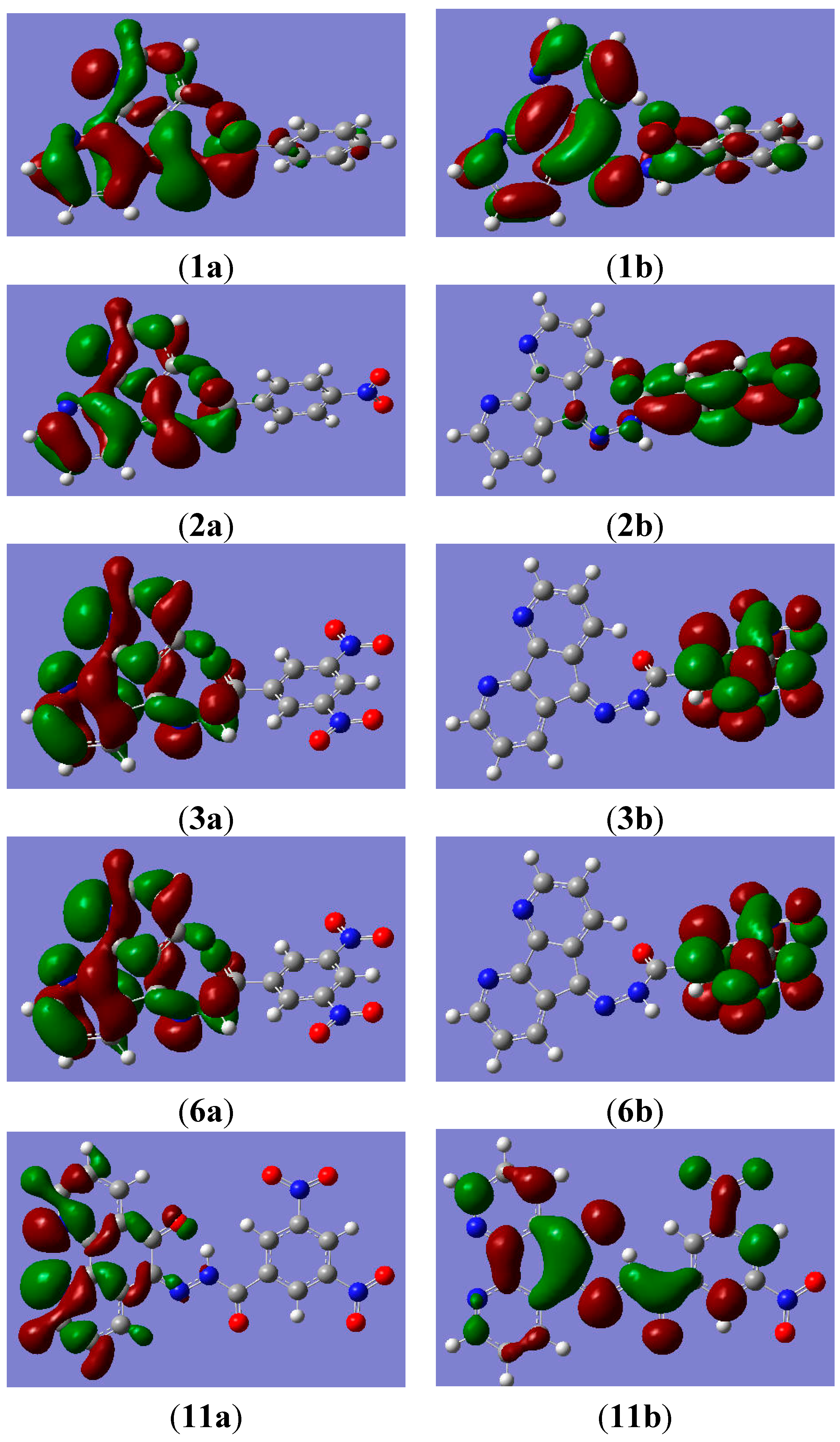Double Properties of Novel Acylhydrazone Nanomaterials Based on a Conjugated System: Anion Binding Ability and Antibacterial Activity
Abstract
:1. Introduction

2. Results and Discussion
2.1. SEM Images of Compounds


2.2. UV-Vis Titration

2.3. Fluorescence Response


2.4. Binding Constant
| Anion | AcO− | H2PO4− | F− |
|---|---|---|---|
| Ks (1) | (5.69 ± 0.56) × 105 | (2.14 ± 0.17) × 104 | (1.02 ± 0.11) × 104 |
| Ks (2) | (4.35 ± 0.41) × 106 | (1.39 ± 0.89)×106 | (1.49 ± 0.38) × 106 |
| Ks (3) | (8.40 ± 0.78) × 106 | (2.73 ± 0.21) × 104 | (7.32 ± 0.03) × 103 |
| Ks (4) | ND | ND | ND |
| Ks (5) | ND | ND | ND |
| Ks (6) | (1.83 ± 0.60) × 107 | (1.81 ± 0.32) × 104 | (1.43 ± 0.02) × 103 |
| Ks (7) | ND | ND | ND |
| Ks (8) | ND | ND | ND |
| Ks (9) | (1.26 ± 0.09) × 103 | (4.45 ± 0.45) × 102 | ND |
| Ks (10) | ND | ND | ND |
| Ks (11) | (4.12 ± 0.10) × 104 | ND | ND |
| Ks (12) | ND | ND | ND |
2.5. Antibacterial Activity

2.6. Theoretical Investigation


3. Experimental Section
4. Conclusions
Supplementary Files
Supplementary File 1Acknowledgments
Author Contributions
Conflicts of Interest
References
- Kado, S.; Otani, H.; Nakahara, Y.; Kimura, K. Highly selective recognition of acetate and bicarbonate by thiourea-functionalised inverse opal hydrogel in aqueous solution. Chem. Commun. 2013, 49, 886–888. [Google Scholar] [CrossRef] [PubMed]
- Santos-Figueroa, L.E.; Moragues, M.E.; Climent, E.; Agostini, A.; Martínez-Máñez, R.; Sancenón, F. Chromogenic and fluorogenic chemosensors and reagents for anions. A comprehensive review of the years 2010–2011. Chem. Soc. Rev. 2013, 42, 3489–3613. [Google Scholar] [CrossRef] [PubMed]
- Shang, X.F.; Du, J.G.; Yang, W.C.; Liu, Y.; Fu, Z.Y.; Wei, X.F.; Yan, R.F.; Yao, N.C.; Guo, Y.P.; Zhang, J.L.; et al. The development and amino acid binding ability of nano-materials based on azo derivatives: Theory and experiment. Mat. Sci. Eng. C 2014, 38, 101–106. [Google Scholar] [CrossRef] [PubMed]
- Spence, G.T.; Chan, C.; Szemes, F.; Beer, P.D. Anion binding induced conformational changes exploited for recognition, sensing and pseudorotaxane disassembly. Dalton Trans. 2012, 41, 13474–13485. [Google Scholar] [CrossRef] [PubMed]
- Schulze, B.; Schubert, U.S. Beyond click chemistry—Supramolecular interactions of 1,2,3-triazoles. Chem. Soc. Rev. 2014, 43, 2522–2571. [Google Scholar] [CrossRef] [PubMed]
- Kim, S.H.; Hwang, I.J.; Gwon, S.Y.; Burkinshaw, S.M.; Son, Y.A. An anion sensor based on the displacement of 2,6-dichlorophenol-indo-o-cresol sodium salt from a water-soluble tetrasulfonated calix[4]arene. Dyes Pigm. 2011, 88, 84–87. [Google Scholar] [CrossRef]
- Yang, Z.; Zhang, K.; Gong, F.; Li, S.; Chen, J.; Ma, J.S.; Sobenina, L.N.; Mikhaleva, A.I.; Trofimov, B.A.; Yang, G. A highly selective fluorescent sensor for fluoride anion based on pyrazole derivative: Naked eye “no-yes” detection. J. Photochem. Photobiol. A 2011, 217, 29–34. [Google Scholar] [CrossRef]
- Lin, Q.; Cai, Y.; Li, Q.; Shi, B.B.; Yao, H.; Zhang, Y.M.; Wei, T.B. Fluorescent “turn-on” detecting CN− by nucleophilic addition induced schiff-base hydrolysis. Spectrochim. Acta A 2015, 141, 113–118. [Google Scholar] [CrossRef] [PubMed]
- Cornes, S.P.; Davies, C.H.; Blyghton, D.; Sambrook, M.R.; Beer, P.D. Contrasting anion recognition behaviour exhibited by halogen and hydrogen bonding rotaxane hosts. Org. Biomol. Chem. 2015, 13, 2582–2587. [Google Scholar] [CrossRef] [PubMed]
- Robinson, S.W.; Mustoe, C.L.; White, N.G.; Brown, A.; Thompson, A.L.; Kennepohl, P.; Beer, P.D. Evidence for halogen bond covalency in acyclic and interlocked halogen-bonding receptor anion recognition. J. Am. Chem. Soc. 2015, 137, 499–507. [Google Scholar] [CrossRef] [PubMed]
- Joo, T.Y.; Singh, N.; Lee, G.W.; Jang, D.O. Benzimidazole-based ratiometric fluorescent receptor for selective recognition of acetate. Tetrahedron Lett. 2007, 48, 8846–8850. [Google Scholar] [CrossRef]
- Grases, F.; March, J.G. Determination of phosphate based on inhibition of crystal growth of calcite. Anal. Chim. Acta 1990, 229, 249–254. [Google Scholar] [CrossRef]
- Sessler, J.L.; Cho, D.G.; Lynch, V. Diindolylquinoxalines: Effective indole-based receptors for phosphate anion. J. Am. Chem. Soc. 2006, 128, 16518–16519. [Google Scholar] [CrossRef] [PubMed]
- Furman, P.A.; Fyfe, J.A.; Clair, M.H., St.; Weinhold, K.; Rideout, J.L.; Freeman, G.A. Phosphorylation of 3ʹ-azido-3ʹ-deoxythymidine and selective interaction of the 5ʹ-triphosphate with human immunodeficiency virus reverse transcriptase. Proc. Natl. Acad. Sci. USA 1986, 83, 8333–8337. [Google Scholar] [CrossRef] [PubMed]
- Velu, R.; Ramakrishnan, V.T.; Ramamurthy, P. Selective fluoride ion recognition by a thiourea based receptor linked acridinedione functionalized gold nanoparticles. J. Photochem. Photobiol. A 2011, 217, 313–320. [Google Scholar] [CrossRef]
- Seguí, M.J.; Lizondo-Sabater, J.; Benito, A. A new ion-selective electrode for anionic surfactants. Talanta 2007, 71, 333–338. [Google Scholar] [CrossRef] [PubMed]
- Kondo, S.; Nagamine, M.; Karasawa, S.; Ishihara, M.; Unno, M.; Yano, Y. Anion recognition by 2,2′-binaphthalene derivatives bearing urea and thiourea groups at 8- and 8ʹ-positions by UV-vis and fluorescence spectroscopies. Tetrahedron 2011, 67, 943–950. [Google Scholar] [CrossRef]
- Bao, X.P.; Zhou, Y.H. Synthesis and recognition properties of a class of simple colorimetric anion chemosensors containing OH and CONH groups. Sens. Actuators B 2010, 147, 434–441. [Google Scholar] [CrossRef]
- Sessler, J.L.; Cho, D.G.; Stepien, M.; Lynch, V.; Waluk, J.; Yoon, Z.S.; Kim, D. Inverted sapphyrin: A new family of doubly N-confused expanded porphyrins. J. Am. Chem. Soc. 2006, 128, 12640–12641. [Google Scholar] [CrossRef] [PubMed]
- Toraskar, M.P.; Kadam, V.J.; Kulkarni, V.M. Synthesis and antifungal activity of some azetidinones. Int. J. Chem. Tech. Res. 2009, 1, 1194–1199. [Google Scholar]
- Khan, K.M.; Rasheed, M.; Ullah, Z.; Hayat, S.; Kaukab, F.; Choudhary, M.I.; Atta-ur-Rahman, A.; Perveen, S. Synthesis and in vitro leishmanicidal activity of some hydrazides and their analogues. Bioorg. Med. Chem. 2003, 11, 1381–1387. [Google Scholar] [CrossRef]
- Lian, S.; Su, H.; Zhao, B.; Liu, W.; Zheng, L.; Miao, J. Synthesis and discovery of pyrazole-5-carbohydrazide N-glycosides as inducer of autophagy in A549 lung cancer cells. Bioorg. Med. Chem. 2009, 17, 7085–7092. [Google Scholar] [CrossRef] [PubMed]
- Zhang, X.; Guo, L.; Wu, F.Y.; Jiang, Y.B. Development of fluorescent sensing of anions under excited-state intermolecular proton transfer signaling mechanism. Org. Lett. 2003, 5, 2667–2670. [Google Scholar] [CrossRef] [PubMed]
- Liu, Y.; Han, B.H.; Zhang, H.Y. Spectroscopic studies on molecular recognition of modified cyclodextrins. Curr. Org. Chem. 2004, 8, 35–46. [Google Scholar] [CrossRef]
- Kubo, Y.; Kato, M.; Yoshihiro Misawa, Y.; Tokita, S. A fluorescence-active 1,3-bis(isothiouronium)-derived naphthalene exhibiting versatile binding modes toward oxoanions in aqueous MeCN solution: New methodology for sensing oxoanions. Tetrahedron Lett. 2004, 45, 3769–3773. [Google Scholar] [CrossRef]
- Xu, Z.; Kim, S.; Lee, K.H.; Yoon, J. A highly selective fluorescent chemosensor for dihydrogen phosphate via unique excimer formation and PET mechanism. Tetrahedron Lett. 2007, 48, 3797–3800. [Google Scholar] [CrossRef]
- Kumar, G.S.; Neckers, D.C. Photochemistry of azobenzene-containing polymers. Chem. Rev. 1989, 89, 1915–1925. [Google Scholar] [CrossRef]
- Harada, J.; Fujiwara, T.; Ogawa, K. Crucial role of fluorescence in the solid-state thermochromism of salicylideneanilines. J. Am. Chem. Soc. 2007, 129, 16216–16221. [Google Scholar] [CrossRef] [PubMed]
- Liu, Y.; You, C.C.; Zhang, H.Y. Supramolecular Chemistry; Nankai University Publication: Tianjin, China, 2001. [Google Scholar]
- Bourson, J.; Pouget, J.; Valeur, B. Ion-responsive fluorescent compounds. 4. Effect of cation binding on the photophysical properties of a coumarin linked to monoaza-and diaza-crown ethers. J. Phys. Chem. 1993, 97, 4552–4557. [Google Scholar] [CrossRef]
- Frisch, M.J.; Trucks, G.W.; Schlegel, H.B.; Scuseria, G.E.; Robb, M.A.; Cheeseman, J.R.; Montgomery, J.A., Jr.; Vreven, T.; Kudin, K.N.; Burant, J.C.; et al. Gaussian03; software for computational chemistry; Gaussian, Inc.: Pittsburgh, PA, USA, 2003. [Google Scholar]
- Maity, D.; Bhaumik, C.; Mondal, D.; Baitalik, S. Photoinduced intramolecular energy transfer and anion sensing studies of isomeric RuIIOsII complexes derived from an asymmetric phenanthroline-terpyridine bridge. Dalton Trans. 2014, 43, 1829–1845. [Google Scholar] [CrossRef] [PubMed]
- Ni, X.L.; Tahara, J.; Rahman, S.; Zeng, X.; Hughes, D.L.; Redshaw, C.; Yamato, T. Ditopic receptors based on lower- and upper-rim substituted hexahomotrioxacalix[3]arenes: Cation-controlled hydrogen bonding of anion. Chem. Asian J. 2012, 7, 519–527. [Google Scholar] [CrossRef] [PubMed]
- Ying, S.M.; Huang, X.H.; Luo, W.K.; Xiao, Y.C. Synthesis, crystal structures and characterizations of two homochiral coordination polymers based on a chiral reduced Schiff base ligand. Acta Crystallogr. C Struct. Chem. 2014, 70, 375–378. [Google Scholar] [CrossRef] [PubMed]
- Lee, S.A.; You, G.R.; Choi, Y.W.; Jo, H.Y.; Kim, A.R.; Noh, I.; Kim, S.J.; Kim, Y.; Kim, C. A new multifunctional Schiff base as a fluorescence sensor for Al3+ and a colorimetric sensor for CN in aqueous media: An application to bioimaging. Dalton Trans. 2014, 43, 6650–6659. [Google Scholar] [CrossRef] [PubMed]
- Sorna, V.; Theisen, E.R.; Stephens, B.; Warner, S.L.; Bearss, D.J.; Vankayalapati, H.; Sharma, S. High-throughput virtual screening identifies novel N′-(1-phenylethylidene)-benzohydrazides as potent, specific, and reversible LSD1 inhibitors. J. Med. Chem. 2013, 56, 9496–9508. [Google Scholar] [CrossRef] [PubMed]
- Zhang, X.J.; Zhang, X.H.; Zou, K.; Lee, C.S.; Lee, S.T. Single-crystal nanoribbons, nanotubes, and nanowires from intramolecular charge-transfer organic molecules. J. Am. Chem. Soc. 2007, 129, 3527–3533. [Google Scholar] [CrossRef] [PubMed]
- Hu, D.H.; Yu, J.; Padmanadan, G.; Ramakrishanan, S.; Barbara, P.F. Spatial confinement of excition transfer and the role of conformational order in organic nanoparticles. Nano Lett. 2002, 2, 1121–1124. [Google Scholar] [CrossRef]
© 2015 by the authors; licensee MDPI, Basel, Switzerland. This article is an open access article distributed under the terms and conditions of the Creative Commons Attribution license (http://creativecommons.org/licenses/by/4.0/).
Share and Cite
Shang, X.; Li, W.; Feng, Y.; Li, X.; Xu, X. Double Properties of Novel Acylhydrazone Nanomaterials Based on a Conjugated System: Anion Binding Ability and Antibacterial Activity. Appl. Sci. 2015, 5, 910-925. https://doi.org/10.3390/app5040910
Shang X, Li W, Feng Y, Li X, Xu X. Double Properties of Novel Acylhydrazone Nanomaterials Based on a Conjugated System: Anion Binding Ability and Antibacterial Activity. Applied Sciences. 2015; 5(4):910-925. https://doi.org/10.3390/app5040910
Chicago/Turabian StyleShang, Xuefang, Wanli Li, Yaqian Feng, Xin Li, and Xiufang Xu. 2015. "Double Properties of Novel Acylhydrazone Nanomaterials Based on a Conjugated System: Anion Binding Ability and Antibacterial Activity" Applied Sciences 5, no. 4: 910-925. https://doi.org/10.3390/app5040910
APA StyleShang, X., Li, W., Feng, Y., Li, X., & Xu, X. (2015). Double Properties of Novel Acylhydrazone Nanomaterials Based on a Conjugated System: Anion Binding Ability and Antibacterial Activity. Applied Sciences, 5(4), 910-925. https://doi.org/10.3390/app5040910





